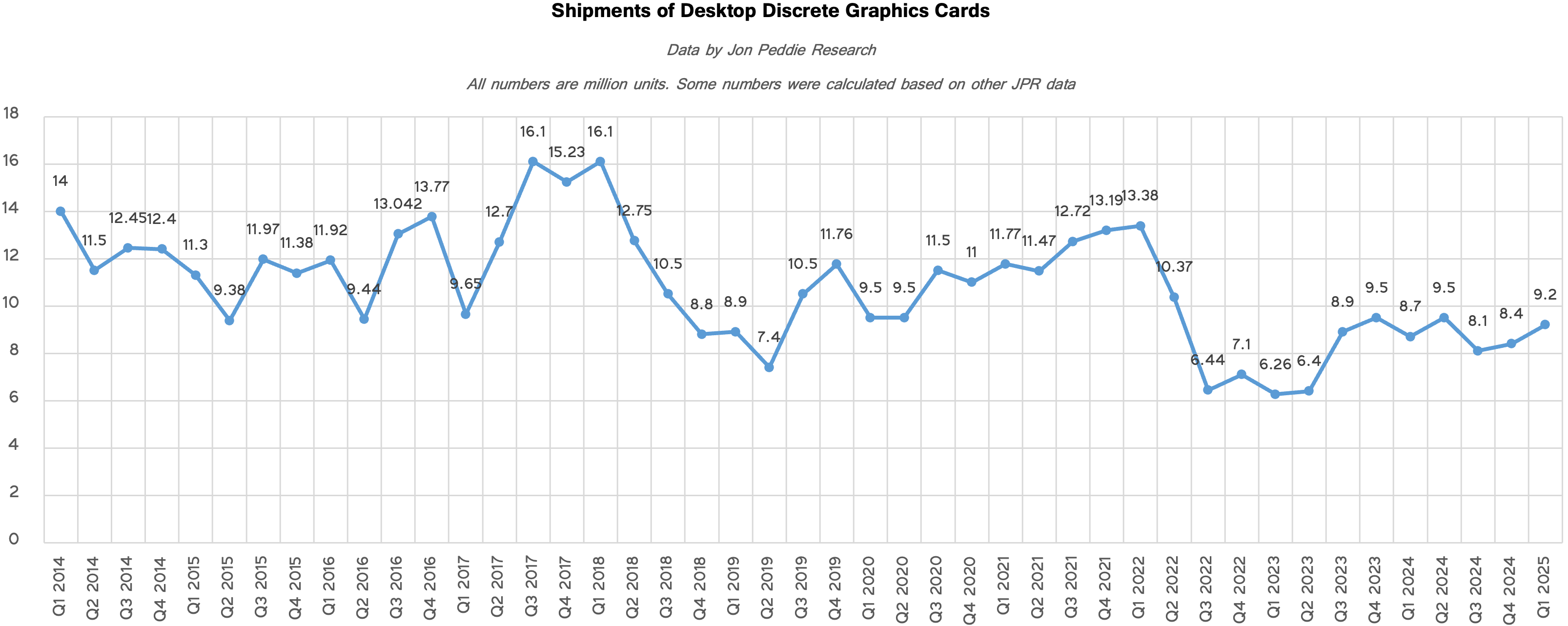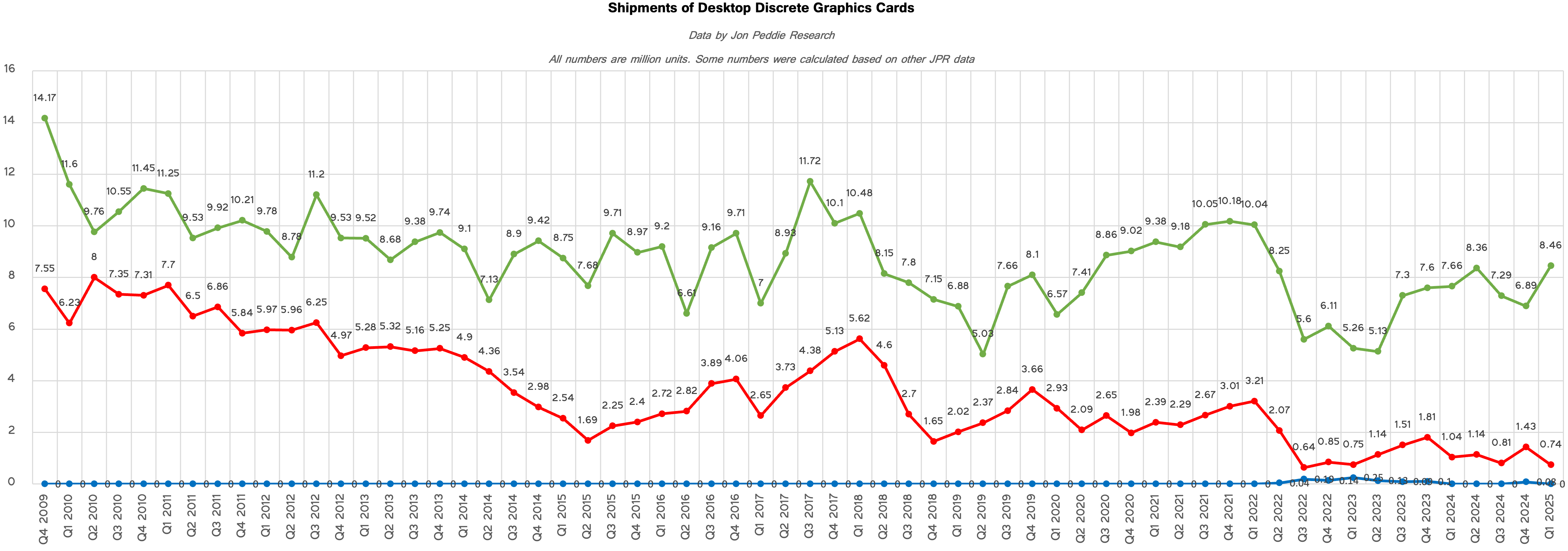AMD's desktop GPU market share hits all-time low despite RX 9070 launch, Nvidia extends its lead [Updated]
So, AMD does not ramp its RDNA 4 GPUs?

Update 6/6/2025 9:00 am ET: Jon Peddie has kindly provided us with comments regarding AMD's GPU business underperformance in Q1 2025. He believes that the sources of AMD's decline in GPU shipments lie in the company's failure to accurately predict demand for its GPU products six to nine months in advance, as well as the necessity to balance its TSMC allocations between Zen CPUs and Radeon GPUs. Read the exact comments below.
AMD's desktop GPU market share, based on sales into the market, has dropped to a historic low in the latest report from Jon Peddie Research, despite the company's launch of new products during the quarter. Discrete GPU shipments for desktop PCs increased significantly both quarter-over-quarter and year-over-year in Q1 2025 and totaled 9.2 million units. However, as both AMD and Nvidia rolled out their new-generation graphics cards in the first quarter, Nvidia managed to sell millions of its new GeForce RTX 50-series GPUs and capture its highest market share, while AMD struggled to sell even 750,000 add-in-boards, which is why its share dropped to a historical low.

Nvidia now commands around 92% of the desktop discrete GPU market, while AMD's share declined to approximately 8%, the company's lowest share ever.
The industry shipped 9.2 million standalone graphics processing units for desktop PCs during the first quarter, up 8.5% compared to the prior quarter and by 5.3% on an annual basis. In terms of market share dynamics, Nvidia was the only major vendor to expand its position, gaining 8.5%. AMD’s share declined by 7.3%, while Intel's share saw a smaller contraction of 1.2%.

AMD's GPU shipments totaled approximately 740,000 to 750,000 units, the company's worst results in three years. To make matters worse, for the first time in decades (if not ever), the quarterly sales of AMD GPUs declined despite the launch of new halo products. Jon Peddie, the head of Jon Peddie Research, believes the poor performance was a result of an AMD demand misprediction in Q1.
Nvidia sold around 8.46 million standalone graphics processors for desktops, the company's best result in three years, especially keeping in mind that the company sold quite expensive products ($379 - $1999) during the first quarter and these products happen to be some of the best graphics cards around.

"AMD and Nvidia have to walk a tight rope wire when it comes to placing orders at fabs like TMSC — and you never get it right all the time," said Jon Peddie, president of Jon Peddie Research, in a conversation with Tom's Hardware. "Forecasting demand six to nine months in advance, when the economic and political environment is so unstable adds an additional layer of complexity. Then you have yield issues on top of it all, and of course you have to get the specs right. Nonetheless, AMD has been doing this for decades and knows all those tradeoffs, plus in their case they have the added burden of balancing resources of demand for Zen CPUs against GPUs."
The numbers from Jon Peddie Research appear to contradict comments made by Lisa Su, Chief Executive of AMD, who stated during the quarter that the launch of the company's Radeon RX 9070-series products was AMD's most successful product launch in terms of first-week sales. Yet, this is not exactly the case. Jon Peddie Research monitors how many GPU chips each company sells-in to its partners per quarter, not the number of cards sold through retailers. By contrast, Lisa Su mentioned sold through results of the Radeon RX 9070-series, referring to the final stage where the retailer sells the product to the end user.
Get Tom's Hardware's best news and in-depth reviews, straight to your inbox.

Images of AMD's early Navi 48 graphics processors — the GPUs that power the Radeon RX 9070-series boards — indicate that their assembly took place in late October 2024, which means that production of the actual silicon started approximately 90 days prior, in late July 2024. This suggests that AMD had been building up inventory for several months ahead of the official launch on March 6, 2025.
While the total number of GPUs and add-in boards accumulated before the release remains unclear, Jon Peddie Research reported back in March that AMD delivered around 1.43 million discrete desktop GPUs to partners in the fourth quarter of 2024. The lion's share of these processors were likely AMD's Navi 48, so it is reasonable to conclude that AMD entered the first quarter of 2025 with a substantial stockpile of Navi 48 chips. Although precise figures are not available, it is likely that AMD's partners shipped well over a million Radeon RX 9070-series graphics cards during the quarter. However, this was a result of accumulating GPUs over a period of about six months.
By contrast, the company AMD supplied its partners with only around 740,000 to 750,000 GPUs (probably mostly Navi 48 and Navi 44, although we are speculating) in the first quarter, which explains why the company could not meet demand for its Radeon RX 9070 and 9060-series products in the second quarter. The reasons why AMD did not ramp up shipments/production of its Radeon RX 9000-series RDNA 4-based GPUs in late Q4 2024 – early Q1 2025 are unclear. However, JPR's numbers indicate that the company had reduced sales (and possibly production) of GPUs from Q4 to Q1, which is an unprecedented event. This likely means that shortages of AMD's latest Radeon products — the Radeon RX 9060 and 9070 series — will persist at least through the second quarter.
"We were surprised to see AMD’s shipments drop so drastically in Q1," said Peddie. "At the same time Nvidia was ramping Blackwell filling any vacuum AMD may have left. Both companies' products have been criticized at the low end, which is traditionally a volume market. But in the past few quarters, the high end has taken off and that is where Nvidia had an open playing field, and so far, still does. So, it is a combination of economic and political instability, and consumer demand shifting to the high end that has caught AMD in a crossfire so to speak."
While shipments of graphics cards were up in the first quarter, sales of desktop processors dropped. JPR reports that the desktop CPU market contracted sharply as volumes dropped by 14.5% year-over-year and 20.6% sequentially.
"The PC market is caught in the crosswinds, some might say crossfire, of Trump's trade wars, with on-again and off-again, special cutout, and changing import/export rules," said Dr. Jon Peddie, president of Jon Peddie Research. "As part of the turmoil, some PC suppliers have pulled back or held orders, while a few have increased orders, hoping to lock in prices. Pre-ordering to lock in prices is a temporary fix, which will cause a depression in future quarters’ sales, as discussed here. We think overall PC sales and, subsequently, client PC GPU sales will be down for the year.”

Follow Tom's Hardware on Google News to get our up-to-date news, analysis, and reviews in your feeds. Make sure to click the Follow button.

Anton Shilov is a contributing writer at Tom’s Hardware. Over the past couple of decades, he has covered everything from CPUs and GPUs to supercomputers and from modern process technologies and latest fab tools to high-tech industry trends.
-
Heat_Fan89 Let's just hope that AMD doesn't get discouraged and bail on the GPU market and leave a 100% monopoly to Nvidia. However Steve Burke has called out AMD many times for their gross mismanagement and GPU strategy.Reply
As GN pointed out in the past (lowering price before release of the 7 series), that AMD doesn't seem to believe in its own products. That could be the case again that AMD didn't make enough product to meet demand because they thought it wouldn't be as popular as an Nvidia product. I remember after the 9070XT post release that some at AMD were surprised at the demand and now they had to scurry to come up with more product to meet demand.
AMD seems to be its own worse enemy. -
DSzymborski I'm just not sure how AMD could have expected any other result. They basically lost market share selling every 9070 XT they could churn out. If they can't produce a lot more, they can't beat Nvidia on price, and if they can't beat Nvidia on price and availability, then they can't beat Nvidia. I have a 5070 Ti, but I would have been very happy to go AMD with my current GPU. But I couldn't get one at $600, $700, or even $800, so $830 for a 5070 Ti didn't seem all that bad, relatively speaking.Reply -
dalek1234 The charts go as far as Q1 '25. RDNA 4 became available to buy in the last month of that quarter.Reply
We are now in the last month of the 2nd quarter. I'll be curious to see those charts again for 2nd quarter, when available. -
-Fran- Historically speaking, nVidia has always produced an order of magnitude more GPUs than AMD. And this time, I wouldn't be surprised it is two orders of magnitude, considering nVidia has the China market cornered (they're effectively a monopoly there).Reply
Also, the usual reminder: the DYI is very vocal, but a minority still. Most of the sales are combined laptop, OEMs, SIs and DYI, out of which, I'd be surprised if it's single digits even.
On the other hand: as long as AMD is selling everything they're producing in the markets they're targeting, they'll grow. The thing is: long term, nVidia may not be worried about AMD outselling them in DYI*, but they'll be scared and start worrying if they encrouch in the bigger markets like OEM (think Dell, HP, etc) and Laptop. SIs, while not much bigger than DYI, AMD at least has a decent presence there.
Well, those are my thoughts.
Regards. -
mitch074 I wouldn't be surprises to learn that it's a wafer + yield problem : AMD are selling as many chips as they can churn out, true - they're also fully active chips running at a high voltage (they all undervolt quite massively).Reply
I wouldn't be surprised to see the market flooded with non-XT and/or GRE models in the next few months, all using cut-down chips because AMD are actually scraping the bottom of the bins... Samsung and/or TSMC have limited production capabilities, and the highest bidder gets most of them.
Currently, that means nVidia. -
acadia11 And this is what happens when you don’t have a Halo product and you don’t have a better product. Simply build a better GPU than Nvidia if you can, and people will buy AMD. Then again Nvidias lead is not just GPU but all the foundational software around it including CUDA that had led to their lead.Reply -
acadia11 Reply
The market doesn’t believe in AmDs GPUs some bargain hunters do, but that’s not where the money is today. But because Nvidia can always match AmD in price in any segment it doesn’t matter. AMd needs to simply build a much better.GPU and capture mind share. Simply put it doesn’t matter what segment it is people think Nvidia is better and performance results support it. There is no formula, or magic strategy be better. The beat out Intel because they started producing better products than Intel, it’s that simple. One can only hope this is AmDs Bulldozer moment until their UDNA based GPUs come along. The answer is simple.Heat_Fan89 said:Let's just hope that AMD doesn't get discouraged and bail on the GPU market and leave a 100% monopoly to Nvidia. However Steve Burke has called out AMD many times for their gross mismanagement and GPU strategy.
As GN pointed out in the past (lowering price before release of the 7 series), that AMD doesn't seem to believe in its own products. That could be the case again that AMD didn't make enough product to meet demand because they thought it wouldn't be as popular as an Nvidia product. I remember after the 9070XT post release that some at AMD were surprised at the demand and now they had to scurry to come up with more product to meet demand.
AMD seems to be its own worse enemy. -
Zaranthos I've wanted an AMD GPU for months now. I check pricing and availability almost daily. I either can't find anything I want, or they're priced far above MSRP. Granted I'm a pretty lazy buyer and somewhat willing to wait, but in the meantime scalpers just buy most everything in sight and sell it for a profit. AMD probably makes far less than the scalper market because they don't produce enough product. The other big problem is probably nearly 100% of their cards are made in China and we all know much of that product is harder to move to the US right now at a decent price. Making almost everything in China isn't working out so well. Yes I would pay more, but not 60%+, which is what some scalpers are selling some cards for, or more.Reply -
acadia11 Reply
gamers are a small segment of the GPU market, gamers really don’t comprehend that GPUs serve a much much larger use case than playing games today, and AMd is still losing because Nvidia still sells more to the gaming market and there is really nothing to discuss in the datacenter/AI and enterprise market. The GPU market is growing as GPUs are used for far more use cases today and Nvidia gets the lions share of every use case in terms of sales.mitch074 said:I wouldn't be surprises to learn that it's a wafer + yield problem : AMD are selling as many chips as they can churn out, true - they're also fully active chips running at a high voltage (they all undervolt quite massively).
I wouldn't be surprised to see the market flooded with non-XT and/or GRE models in the next few months, all using cut-down chips because AMD are actually scraping the bottom of the bins... Samsung and/or TSMC have limited production capabilities, and the highest bidder gets most of them.
Currently, that means nVidia.